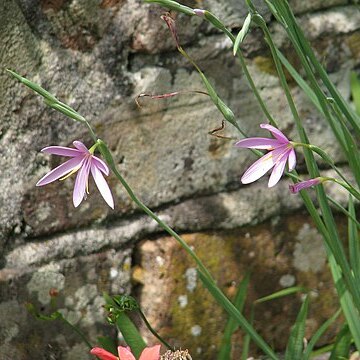Perennial herb, geophyte, 0.1-0.3 m; corm turbinate with concentric tunics; stem simple or rarely 1-branched, erect. Leaves 4, lower 2 basal, the other sheathing, straight or falcate, (sub)acute, margins thickened; midrib raised, secondary veins visible on both surfaces. Bracts green, often reddish at apex. Inflorescence a 5-15-flowered spike; flowers bright magenta-pink; perianth tube 6.0-12.5 mm long, dilated in throat; tepals subequal 12-16 x 4.5-5.0 mm, open in sunlight. Stamens exserted; filaments 3-4 mm long; anthers 6.0-8.5 mm long. Flowering time Dec.-Mar. Capsule oblong.
A herb which produces a corm. It grows 30-60 cm tall. The leaves at the base are long and narrow. They are 3 mm wide. The flowers are in spikes of up to 20. They are on stalks 40 cm high. These are zigzag. The fruit is an oval, thin-walled capsule. The seeds are oval and brown.

